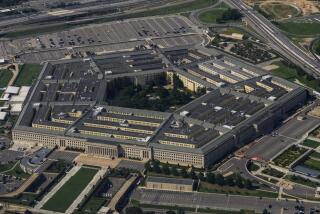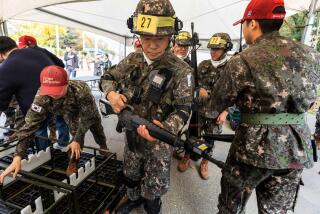Army is training advisors for Iraq
- Share via
FT. RILEY, KAN. — Within the Army’s tightly knit community of counterinsurgency experts, Lt. Col. John Nagl is something of a star.
When the Army and Marine Corps decided to rewrite their field manual on how to fight insurgents last year, Nagl was chosen as one of its authors. His doctoral thesis on guerrilla wars was just republished in paperback with an approving foreword by the Army’s chief of staff.
For the record:
12:00 a.m. Oct. 28, 2006 For The Record
Los Angeles Times Saturday October 28, 2006 Home Edition Main News Part A Page 2 National Desk 1 inches; 53 words Type of Material: Correction
Military advisors: An article in Wednesday’s Section A about the Army’s training of advisors for Iraq was accompanied by a box that said James Willbanks was director of the history department at the U.S. Military Academy. Willbanks is director of the military history department at the U.S. Army Command and General Staff College.
But when Nagl’s two-year stint in the Pentagon ended this month, he did not, like most accomplished soldiers of his rank, take command of an armored battalion headed back to Iraq. Instead, he shipped out to this sprawling base in rural Kansas where the Army is attempting what some consider its most ambitious structural change since the Vietnam War.
Here, amid rolling fields dotted by scores of quickly built barracks, the Army is building a training base that by early next year will be turning as many as 2,000 of its most promising midlevel officers into military advisors every two months, most of them headed to Iraq.
The mission reflects the U.S. military’s vision of its long-range role in Iraq -- as advisors for local forces that will be doing the actual fighting. But it represents something of a gamble as well: The effort is sucking thousands out of their normal combat deployments at a time when American forces are facing personnel shortages as violence in Iraq surges.
It is also a signal that, as commanders in Iraq move to re-evaluate tactics in the wake of a faltering Baghdad offensive and rising U.S. casualties, the work of military advisors is likely to emerge as a pillar of any plan to withdraw American troops. In Baghdad on Tuesday, Army Gen. George W. Casey Jr., commander of U.S. forces in Iraq, said it might take more U.S. troops to quell violence in Baghdad.
There are 3,600 military advisors in Iraq training, organizing and accompanying Iraqi units into action. But as the effort at Ft. Riley ramps up, Army officials acknowledge that number could grow by thousands in the coming months -- and perhaps tens of thousands once Afghanistan is added to the program.
“This is much bigger than ... sending Special Forces teams down to El Salvador or Colombia to work in small groups,” said Gen. Richard A. Cody, the Army’s vice chief of staff, referring to past U.S. advisory efforts.
The size and scope of the new effort, which began in June with the arrival at Ft. Riley of the first class of prospective advisors, is a sign of how seriously the Army is taking the mission.
“I feel like we’ll be the last men standing at the end of the U.S. presence here,” said Brig. Gen. Dana Pittard, the Army officer sent to Baghdad in July to take over the advisor program.
The Army has begun pouring resources into the effort. Gen. Peter J. Schoomaker, the Army’s chief of staff, has assigned an entire division headquarters -- the 1st Infantry, one of 10 Army divisions -- to take over the training mission, and has ordered two of its combat brigades to rid themselves of all their tanks and infantrymen to devote their officers exclusively to training advisors.
“The fact he took one of his divisions, at a time he needs divisions, and two heavy brigades, at a time he needs heavy brigades, that by itself speaks volumes of how important this is,” said Maj. Gen. Carter F. Ham, the 1st Infantry’s new commander.
In April, the Army added incentives to persuade its best officers to volunteer for the program. The most attractive is a guarantee that volunteers will get an assignment of their choice after a year as an advisor.
The advisor program’s effects are already visible. Kalev Sepp, an instructor at the Naval Postgraduate School, said he was taken aback when, before a recent lecture to Iraq combat veterans taking a course for captains at Ft. Knox, Ky., he was repeatedly told by officers that they were headed to Ft. Riley.
“I finally just said, ‘How many people here are going back to Iraq as advisors?’ and half the people in the room raised their hand,” said Sepp, who was a military advisor as a Special Forces major in El Salvador 17 years ago. “That’s extraordinary.”
But until the start of the year, the Army’s attention to its military advisor program was haphazard at best.
The concept started on an ad hoc basis. Early in the Iraq war, some commanders adapted quickly to fighting a counterinsurgency and set up embedded military advisor teams on the fly.
Most prominently, Lt. Gen. Peter W. Chiarelli -- who in early 2004 was the 1st Cavalry Division commander in Baghdad’s Sadr City slums but now commands all ground forces in Iraq -- took hundreds of his soldiers from their assigned units to create 70 small teams who “lived, ate and trained with the Iraqi army,” Chiarelli wrote in a summary of his deployment.
Maj. Gen. John Batiste, who commanded the 1st Infantry Division the same year, took similar steps in the Sunni Triangle north of Baghdad.
But Chiarelli and Batiste were exceptions to the rule. Most commanders, when ordered to provide soldiers for military training teams -- dubbed MiTTs -- would turn over those not needed for essential operations.
“Some took it very seriously and picked very good people,” Pittard said. “Some said, ‘Well, who can we spare?’ ”
The result was predictable. When Sepp, who has traveled to Iraq as a counterinsurgency advisor to U.S. commanders, met military trainers in Taji as recently as December, he was “unimpressed with the quality of people.”
“The lieutenant colonel that I met there, the first thing on his mind was how much longer he had before he left,” Sepp recalled. “He had it down to hours. He was completely uninterested in what they were doing.”
Advisor teams were thrown together and, in many cases, did not meet one another until arriving in Iraq -- a drastic change for combat units who normally spend a year together before deployment.
While the huge shift underway at Ft. Riley will address many of the earlier problems, it also raises some new ones.
The Army is scrounging for soldiers to send to Iraq in combat brigades. Two senior military planners said in interviews that the move to push thousands of officers into advisory roles has exacerbated readiness problems plaguing the Army.
The advising mission is particularly debilitating because it is officer-heavy. The typical 11-person U.S. team sent to advise an Iraqi battalion consists of five enlisted officers above the rank of staff sergeant and six commissioned officers.
Cody acknowledged the overhaul of the advisor mission will “put added strain on the force.” He said the Army was compensating by filling some senior officer jobs with more junior officers, particularly in units that have recently returned from Iraq.
Perhaps more troubling, however, is the time it has taken to make the advisor program a priority. Though Defense Secretary Donald H. Rumsfeld and President Bush have mentioned military advisors as central to plans to hand security duties to Iraqis, it has taken three years to begin to fix the program.
Counterinsurgency experts said the U.S. must make a long-term commitment to the program and support the Iraqi military with money and American airpower, or risk a catastrophic, Vietnam-like collapse of the Iraqi armed forces.
But it is unclear how long the Army is willing to stay with the program. Ham, the 1st Infantry commander, said he viewed the training mission as a two- to three-year commitment. Cody said he was preparing for five years.
But even that might not be long enough. Nagl, the Army guerrilla war expert, pointed out that the British counterinsurgency that began in 1948 in Malaya lasted 12 years.
“These are long wars,” Nagl said. “These are long, hard wars.”
*
(BEGIN TEXT OF INFOBOX)
Advisors in Vietnam
The last time the Pentagon employed military advisors on a large scale was in Vietnam.
The first American soldiers in Vietnam were advisors -- about 16,000 by the time Lyndon B. Johnson assumed the presidency in 1963, said James Willbanks, director of the history department at the U.S. Military Academy and a former military advisor in Vietnam.
Gen. William Westmoreland downgraded the effort when large-scale combat forces were deployed in the mid-1960s.
It wasn’t until President Nixon ordered the policy of “Vietnamization” that the advisors’ mission was reemphasized. But by then, the U.S. was itching to pull out of Vietnam, and the withdrawals undermined the South Vietnamese army, Willbanks said.
Source: Los Angeles Times
More to Read
Sign up for Essential California
The most important California stories and recommendations in your inbox every morning.
You may occasionally receive promotional content from the Los Angeles Times.










